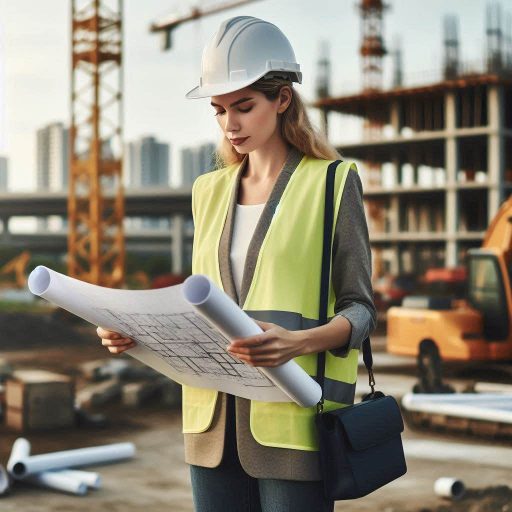Introduction
Landscape architects play a crucial role in designing outdoor spaces that blend beauty and functionality.
Their work involves a deep understanding of the environment, human needs, and design principles.
These professionals are responsible for a variety of tasks, including site analysis, conceptual design, project management, and implementation of landscape plans.
To achieve high-quality results, landscape architects must utilize essential tools tailored to their unique needs.
The right tools not only streamline the design process but also enhance accuracy and productivity.
For instance, software tools enable them to create detailed site plans, perform simulations, and visualize designs in 3D.
Additionally, tools such as drafting equipment, surveying instruments, and materials databases are invaluable for gathering data and making informed decisions.
These resources help landscape architects assess site conditions and develop effective solutions that align with environmental standards.
By investing in the right tools, landscape architects can significantly improve their work quality and efficiency.
They can tackle complex projects more effectively and deliver exceptional outcomes that meet client expectations.
Ultimately, utilizing essential tools empowers landscape architects to create beautiful, functional spaces that enhance the quality of life in our communities.
Handheld GPS Devices
Handheld GPS Devices for Landscape Architects
Firstly, Handheld GPS devices play a crucial role for landscape architects.
They provide accurate mapping of land and terrain.
These devices enhance surveying efficiency and improve project planning.
With advanced technology, handheld GPS devices deliver precise geographical data.
This data helps architects visualize site conditions accurately.
Examples of popular handheld GPS devices used in the industry
Many popular handheld GPS devices cater to the needs of landscape architects.
The Garmin GPSMAP 66i is a favorite.
It combines GPS tracking with satellite communication, ensuring connectivity even in remote areas.
Another excellent option is the Trimble Geo 7X, known for its accuracy and rugged design.
This device excels in collecting and processing spatial data.
The Leica Zeno 20 is also a top choice, offering real-time kinematic (RTK) positioning.
It ensures high precision for intricate landscape designs.
Benefits of using handheld GPS devices for precise measurements and surveying
Using handheld GPS devices offers numerous benefits.
First, they provide precise measurements essential for effective planning.
Accurate data ensures landscape architects can create detailed designs tailored to specific sites.
This precision minimizes errors during the planning phase.
Second, handheld GPS devices streamline the surveying process.
They allow architects to collect data directly on-site.
This efficiency saves time compared to traditional surveying methods.
As a result, landscape architects can focus on design and creativity instead of logistical challenges.
Handheld GPS devices also contribute to environmental considerations.
By accurately mapping land features, architects can plan sustainable designs.
These devices help identify critical areas such as wetlands and wildlife habitats.
Recognizing these features is vital for environmentally responsible planning.
Additionally, many handheld GPS devices integrate with mapping software.
This feature allows architects to visualize data in a user-friendly format.
Architects can create detailed maps, enhancing their presentations to clients and stakeholders.
Visual aids can significantly impact client decisions and project approvals.
Handheld GPS devices are essential tools for landscape architects.
They provide accurate mapping, streamline surveying, and facilitate collaboration.
By using these devices, landscape architects can enhance their design processes.
Investing in reliable handheld GPS technology ultimately leads to better project outcomes and sustainable landscapes.
With the right tools, landscape architects can transform visions into reality while preserving the natural environment.
Pruning Tools
When tackling landscaping projects, the right pruning tools become essential.
These tools maintain the health and aesthetics of plants and trees.
Every landscape architect should equip themselves with the following key pruning tools.
Description of essential pruning tools such as pruning shears, loppers, and saws
Pruning Shears
Pruning shears, often called hand pruners, serve as fundamental tools for cutting smaller branches and stems.
They come in various sizes and styles, including bypass pruners and anvil pruners.
Bypass pruners excel at making clean cuts on live branches.
Anvil pruners work better on deadwood, making them a valuable addition to your toolkit.
The sharp blades of pruning shears allow for precise cuts, promoting healthier plant growth.
Loppers
Loppers represent larger pruning shears featuring long handles.
They are designed specifically for cutting thicker branches that regular pruners cannot handle.
These tools provide more leverage, making it easier to slice through tough branches.
By using loppers, you can avoid straining your hands or wrists, allowing for longer, more productive pruning sessions.
Their robust design helps maintain your landscaping with efficiency and ease.
Saws
For larger branches and limbs, a pruning saw is indispensable.
Various types of pruning saws exist, including folding saws, bow saws, and pole saws.
Each type caters to specific pruning tasks, ensuring you have the right tool for your needs.
Folding saws offer portability and convenience, while bow saws provide stability for heavier cuts.
Pole saws enable you to reach high branches without needing a ladder.
Selecting the appropriate saw helps you tackle any pruning challenge.
Now that you understand the essential pruning tools, let‘s explore the importance of maintaining and shaping plants and trees in landscaping projects.
Importance of Maintaining and Shaping Plants and Trees
Proper pruning enhances the visual appeal of landscapes while promoting overall health and growth.
Here are several reasons why maintaining and shaping plants and trees is crucial.
Health
Regular pruning removes dead or diseased branches, significantly improving air circulation and sunlight exposure.
This fosters healthier plant growth and strengthens the overall structure.
By reducing the risk of pest infestations and disease spread, you keep plants resilient.
A healthy landscape thrives, showcasing vibrant colors and robust foliage.
Aesthetics
Pruning allows you to shape plants and trees, creating a neat and balanced landscape design.
By removing overgrown or unruly branches, you enhance the garden’s visual appeal.
Shaping each plant highlights its natural beauty, contributing to an inviting atmosphere.
A well-maintained landscape attracts attention and enhances property value.
Growth and Productivity
Proper pruning stimulates new growth and encourages flowering and fruit production.
By strategically trimming branches, you promote branching and bud development.
This leads to healthier blooms and more abundant fruits, ensuring your landscape flourishes.
Productive plants contribute to a vibrant garden that captivates onlookers.
Now that you grasp the importance of maintaining and shaping plants and trees, let‘s discuss tips for choosing the right pruning tools for various types of plants and trees.
Tips on Choosing the Right Pruning Tools
When selecting pruning tools, consider the specific needs of each plant or tree you work with.
Here are some helpful tips to guide your choices.
Know Your Plant Species
Familiarize yourself with the different types of plants and trees in your landscape.
Some may require delicate pruning, while others need more aggressive trimming.
Understanding the specific requirements of each species ensures you choose the most effective tools.
Consider Branch Size
Choose pruning shears, loppers, or saws based on the size of branches you‘ll cut.
Using the right tool ensures clean, precise cuts that won‘t damage the plant.
A well-matched tool prevents unnecessary injury to both the plant and the user.
Ergonomics and Comfort
Pruning can be physically demanding, so prioritize ergonomic designs and comfortable grips.
These features minimize hand fatigue and strain during use.
Lightweight tools with adjustable handles enhance comfort, allowing for longer pruning sessions without discomfort.
By following these tips and using the right pruning tools, you can effectively maintain and shape plants and trees in your landscaping projects.
This ensures beautiful and healthy outdoor spaces for years to come.
A well-pruned landscape not only provides aesthetic value but also promotes the long-term health of your plants
Read: Collaborating with Other Creative Roles
Drone Technology
Drone technology has transformed landscape architecture, offering innovative solutions for aerial mapping and monitoring.
Landscape architects now utilize drones to gain insights into sites quickly and accurately.
Drones provide a bird’s-eye view of landscapes, enabling professionals to analyze terrain and vegetation effectively.
Aerial Mapping and Monitoring
Aerial mapping is one of the most significant applications of drones.
They capture high-resolution images and create detailed topographical maps.
This mapping aids in understanding the landscape‘s contours, drainage patterns, and vegetation cover.
Architects can use this data to make informed decisions during the design process.
Drones can survey large areas much faster than traditional methods, saving time and reducing labor costs.
Additionally, drones offer real-time monitoring of projects.
Landscape architects can track construction progress and assess changes in the environment over time.
Regular aerial imagery allows professionals to identify potential issues early.
By spotting problems early, architects can implement solutions before they escalate, ensuring project success.
Benefits of Using Drones
Using drones in landscape architecture offers several benefits.
Transform Your Career Today
Unlock a personalized career strategy that drives real results. Get tailored advice and a roadmap designed just for you.
Start Now- Enhanced Visualization: Aerial imagery allows for stunning visual presentations.
This helps clients understand design proposals more effectively. - Detailed Imaging: Drones capture detailed images of landscapes.
This clarity aids in design accuracy and decision-making. - Cost-Effectiveness: Drones reduce the need for extensive ground surveys.
This cost-effective approach allows for better resource allocation. - Real-Time Data: Drones provide real-time data collection.
This immediacy enables timely adjustments to project plans. - Safety: Drones minimize risks associated with on-site surveying.
They can access dangerous or unstable areas without putting personnel at risk.
Considerations for Selecting the Right Drone
When selecting the right drone for landscape projects, several considerations come into play.
First, consider the camera quality.
A high-resolution camera is crucial for capturing detailed images.
Look for drones equipped with 4K cameras to ensure clarity and detail.
Additionally, consider the drone’s flight time.
Longer battery life allows for extended mapping sessions without frequent recharging.
Next, assess the drone’s range and GPS capabilities.
A drone with a long range can cover larger areas efficiently.
GPS functionality ensures accurate mapping and positioning, which is vital for project planning.
Also, consider the ease of use.
User-friendly drones allow landscape architects to operate them without extensive training.
Another essential factor is the drone’s durability.
Landscape projects often occur in various environments, from rugged terrains to urban settings.
A robust drone withstands challenging conditions and minimizes downtime due to repairs.
Lastly, check for software compatibility.
Some drones come with specialized software for mapping and analysis, streamlining the workflow.
Drone technology has become indispensable in landscape architecture.
Its capabilities for aerial mapping and monitoring enhance project efficiency and effectiveness.
By carefully selecting the right drone, landscape architects can harness this technology to create stunning and functional landscapes.
Drones not only improve the design process but also enhance communication with clients, paving the way for successful projects.
Read: Historic Costume Design Inspirations
Soil Testing Kits
Soil testing kits play a crucial role in landscape architecture.
They help professionals understand soil quality and composition.
Proper analysis informs design decisions, plant selection, and sustainable practices.
Testing soil allows landscape architects to identify nutrient deficiencies and pH levels.
These factors directly impact plant health and growth.
Importance of Soil Testing
Understanding soil characteristics ensures successful landscaping.
Key reasons for soil testing include:
- Nutrient Assessment: Soil tests reveal nutrient levels, guiding fertilizer use.
- pH Level Evaluation: Testing helps determine soil acidity or alkalinity, which affects plant growth.
- Soil Texture Analysis: Knowing soil texture aids in selecting appropriate plants and amendments.
- Contamination Detection: Tests can identify harmful substances, ensuring a safe environment.
Types of Soil Testing Kits
Numerous soil testing kits are available on the market.
Each kit offers unique features for different needs:
- DIY Kits: These kits often include simple tools for basic testing.
Users can analyze pH, nitrogen, phosphorus, and potassium levels. - Professional Kits: Designed for advanced users, these kits provide comprehensive testing.
They often require lab analysis for accurate results. - Digital Soil Testers: These electronic devices offer instant readings.
They measure pH and moisture levels quickly and efficiently. - Specialized Kits: Some kits focus on specific tests, like heavy metals or organic matter.
These are beneficial for specific landscaping projects.
How to Use Soil Testing Kits
Using a soil testing kit involves a few simple steps.
Follow this guide to analyze soil quality and composition:
Collect Soil Samples
- Dig several small holes in different areas of your landscape.
- Use a clean container to collect samples from each location.
Mix Samples
- Combine samples in a clean bucket.
- Remove debris and large particles for accurate testing.
Follow Kit Instructions
- Open your soil testing kit and read the instructions carefully.
- Each kit may have different procedures, so follow them closely.
Perform Tests
- Use the provided tools to test pH, nutrients, or other desired parameters.
- Wait for results as specified by the kit instructions.
Analyze Results
- Compare your results with recommended soil conditions for your chosen plants.
- Make amendments as necessary to improve soil quality.
Soil testing kits are essential tools for landscape architects.
They provide vital insights into soil quality and composition.
With various options available, professionals can choose the right kit for their needs.
Following a step-by-step guide allows for accurate analysis, enhancing the overall quality of landscape designs.
Emphasizing soil health ultimately leads to successful and sustainable landscaping projects.
Read: Freelance vs. In-House Costume Design Jobs

Landscape Design Software
When it comes to landscape architecture, utilizing design software can greatly enhance the efficiency and accuracy of your work.
These programs offer a wide range of features and tools that can help you bring your creative vision to life in a digital format.
Introduction to Popular Landscape Design Software Programs
- AutoCAD: This widely-used software allows for precise 2D and 3D drafting of landscape designs.
- SketchUp: Known for its user-friendly interface, SketchUp is great for creating 3D models and presentations.
- Lumion: With Lumion, architects can create stunning visualizations and walkthroughs of their designs.
- Vectorworks Landmark: Specifically designed for landscape professionals, Vectorworks Landmark offers tools for site planning and landscape design.
- Rhino: Ideal for complex 3D modeling, Rhino is popular among architects for its versatility.
Features and Tools Offered by Landscape Design Software
These programs come equipped with a variety of tools that make designing and visualizing landscapes much easier:
- 3D Modeling: Create detailed 3D models of your designs for a more realistic representation.
- Site Analysis: Analyze site conditions such as topography and sun exposure to inform your design decisions.
- Plant Libraries: Access extensive libraries of plants and trees to populate your designs.
- Rendering: Produce high-quality renderings of your designs to effectively communicate your ideas to clients.
- Collaboration Tools: Share designs with clients and team members for feedback and collaboration.
Benefits of Using Landscape Design Software
There are numerous advantages to incorporating design software into your workflow as a landscape architect
- Efficiency: Save time and effort by quickly generating digital designs and modifications.
- Accuracy: Ensure precise measurements and scale in your designs for better implementation.
- Professionalism: Impress clients with sophisticated visualizations and presentations of your concepts.
- Exploration: Experiment with different design ideas and scenarios to find the optimal solution for your project.
- Client Communication: Easily present and explain your designs to clients in a clear and visually engaging manner.
Landscape design software plays a crucial role for modern architects.
It streamlines workflows and enhances design capabilities.
Additionally, it helps architects communicate their ideas effectively to clients.
Read: Building a Portfolio for Costume Design
Watering Systems
Installing efficient watering systems in landscape projects is crucial for maintaining healthy plant life.
Proper hydration ensures that plants flourish, contributing to the overall aesthetic of the landscape.
Without sufficient water, plants can wither and die, which ruins the beauty of any outdoor space.
Landscape architects must prioritize effective watering systems to keep their designs vibrant and sustainable.
Types of Watering Systems
Landscape architects can choose from various watering systems to meet their project needs.
Two common options include drip irrigation and sprinkler systems.
Each system has its unique benefits and applications, allowing for flexibility in design and implementation.
Drip Irrigation
Drip irrigation is a popular choice for landscape architects seeking to provide targeted hydration.
This system delivers water directly to the roots of plants, minimizing waste.
By focusing water where it is needed most, drip irrigation promotes healthy plant growth and reduces overall water usage.
When designing a drip irrigation system, consider the specific water needs of each plant.
Different plants have varying hydration requirements, which can influence system design.
Ensure that the system is installed correctly to avoid leaks or blockages, which can lead to inefficient watering and plant stress.
Regular maintenance is essential to keep the system functioning optimally.
Sprinkler Systems
Sprinkler systems offer another effective way to water large areas efficiently.
These systems can cover wide spaces and ensure that plants receive consistent hydration.
Sprinklers can be set on timers, making it easier to manage watering schedules without manual intervention.
When incorporating a sprinkler system into a landscape project, position the sprinklers strategically.
Ensure that all areas of the garden receive even coverage to avoid dry patches.
Overwatering can be just as damaging as underwatering, so calibrate the system to prevent excess runoff and wastage.
Designing and Implementing Watering Systems
Proper design and implementation of watering systems are critical for landscape project success.
Following a few key steps will help ensure that plants receive the hydration they need.
- Conduct Thorough Research: Research the water requirements of different plant species before designing the watering system.
Each plant has unique hydration needs, influencing system design. - Assess Environmental Factors: Consider factors such as soil type, sun exposure, and plant density.
These elements impact how water is absorbed and retained in the landscape. - Choose the Right System: Select the appropriate watering system based on the specific needs of the plants.
Choose a system that aligns with the landscape‘s overall design and maintenance goals. - Regular Monitoring; Regularly monitor the watering system for leaks, clogs, or other performance issues.
Early detection of problems allows for timely repairs, ensuring that the system operates efficiently. - Adjust Watering Schedules: Adjust the watering schedule as needed to account for weather changes or plant growth.
Seasonal variations can significantly impact water needs.
By following these tips and selecting the right watering system for landscape projects, architects can create thriving gardens.
Well-hydrated plants enhance the visual appeal of outdoor environments, promoting sustainability and enjoyment for years to come.
With careful planning and execution, effective watering systems can contribute to the overall success of landscape architecture.
See Related Content: How to Build a Strong Portfolio in Web Design
Transform Your Career Today
Unlock a personalized career strategy that drives real results. Get tailored advice and a roadmap designed just for you.
Start NowProtective Gear
Landscape architecture involves outdoor work that can expose professionals to various hazards.
As a result, wearing protective gear is essential for safety.
This blog section explores the necessity of protective gear, essential items, and the importance of preventing injuries while working on landscaping projects.
Why Protective Gear is Necessary
Landscape architects often work in environments that present numerous risks.
They handle heavy equipment, work with sharp tools, and navigate uneven terrain.
Exposure to harmful chemicals, insects, and extreme weather can also pose risks.
Therefore, wearing protective gear helps mitigate these hazards and ensures the safety of landscape architects.
Essential Protective Gear Items
Landscape architects should always wear the following essential protective gear:
- Safety Goggles: Safety goggles protect the eyes from flying debris, chemicals, and dust.
They provide a clear line of sight while safeguarding against potential injuries. - Gloves: Protective gloves shield hands from cuts, scrapes, and chemicals.
They also provide a better grip on tools and materials. - Work Boots: Sturdy work boots with slip-resistant soles prevent slips and falls on uneven surfaces.
Steel-toed boots also protect against heavy objects. - Hearing Protection: Earplugs or earmuffs protect against loud noises from machinery and equipment.
Prolonged exposure to high noise levels can lead to hearing loss. - Hard Hats:Hard hats protect the head from falling objects and impacts.
They are crucial in construction zones and areas with overhead hazards. - Respirators: Respirators protect against inhaling harmful dust and fumes.
They are especially important when using chemicals or working in dusty environments.
Importance of Staying Safe
Safety should always be a top priority for landscape architects.
Wearing appropriate protective gear can significantly reduce the risk of injury.
By taking precautions, professionals can focus on their work without constant worry about potential hazards.
Moreover, preventing injuries leads to a more productive work environment.
Injuries can result in costly downtime and impact project timelines.
Therefore, investing in quality protective gear is not just about safety it is also about efficiency and professionalism.
Protective gear is essential for landscape architects working outdoors.
By wearing safety goggles, gloves, work boots, and other protective items, professionals can reduce their risk of injury.
Prioritizing safety ensures a productive work environment while allowing landscape architects to excel in their projects.
Conclusion
The use of essential tools is fundamental for landscape architects aiming to design, plan, and execute successful projects.
These tools not only enhance the creativity and functionality of outdoor spaces but also improve efficiency and precision.
High-quality tools enable landscape architects to manage every phase of a project, from initial concept to final execution, with greater accuracy and effectiveness.
Invest in advanced design software to visualize plans and ensure precision in measurements with top-tier tools.
Use specialized equipment to implement sustainable solutions that enhance the quality of work.
Professionals who invest in cutting-edge technology and reliable tools can streamline processes, reduce errors, and create more innovative and sustainable designs.
Upgrading and maintaining these tools ensures that landscape architects remain competitive in a fast-evolving industry.
The right tools significantly impact the success of landscaping projects.
They help architects deliver exceptional results. These tools enable architects to meet or exceed client expectations effectively.
Prioritizing quality equipment is a smart investment in their career.
[E-Books for Sale]
The Big Book of 500 High-Paying Jobs in America: Unlock Your Earning Potential
$19.99 • 500 High-Paying Jobs • 330 pages
Explore 500 high-paying jobs in America and learn how to boost your career, earn more, and achieve success!
See All 500 High-Paying Jobs of this E-Book
1001 Professions Without a Degree: High-Paying American Jobs You Can Start Now
$19.99 • 1001 Professions Without a Degree • 174 pages
Discover 1001 high-paying jobs without a degree! Unlock career tips, skills, and success strategies for just $19.99!




